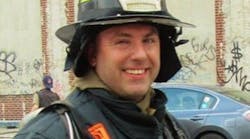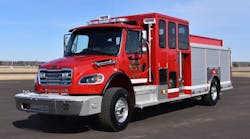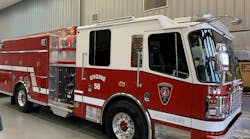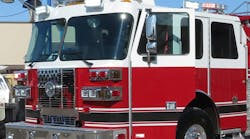Among the most dangerous intersections are those that contain multi-lanes. What makes these particular intersections so dangerous? Why is this more of a problem now than it was 10 years ago?
We will start with a scenario as illustrated in the diagram. You are responding with lights, siren and air horn to a report of smoke in a house. It is 1 P.M.; it is raining heavily and it is 85 degrees with 90 percent humidity and heavy winds. You are driving an aerial ladder 10 mph below the posted speed limit, due to the weather conditions.
As you drive down the road, you come to a known hazardous multi-lane intersection. You come to a complete stop, as per the vehicle and traffic laws. The drivers of the first car in each of the three lanes hear your siren and air horn, and see your warning lights. They yield the right-of-way to you. You look left-right-left. Assured of the right-of-way, you proceed through the red light, unaware it is about to turn to green. You are traveling at less than 15 mph.
All of a sudden you are shaken, you hear a crash and you come to a sudden stop, neither hearing or seeing another vehicle. You set the parking brake, jump out of the apparatus and find a car with two dead civilians and two other civilians who are badly hurt. Why did it happen? Who is to blame? Who is liable? Were there any contributing factors? Was this accident preventable?
First, what makes this intersection so dangerous? The fact that it has multi-lanes certainly plays a part. A few years ago, the term “shotgun alley” started to be used by emergency vehicle operators. Shotgun alley is an unoccupied lane in a multi-lane intersection. It is when two out of three lanes are full of cars yielding the right-of-way to emergency vehicles; the driver of the last vehicle in line, not knowing why traffic has stopped, pulls out into the unoccupied third lane. That driver, not seeing or hearing the emergency vehicle and having the green light, ends up underneath the emergency vehicle. This new hazard in our scenario is similar but different; when all the lanes are full, cars then cross a double yellow line or take the shoulder of the road to try and beat other traffic to the intersection. These civilians generally cannot hear us, cannot see us and are traveling too fast.
Why is this more of a problem now than it was 10 years ago? Many states now have laws that make it legal to turn right on a red light after yielding to traffic. That has complicated the emergency vehicle operators’ job. We have civilians making left turns on green arrows, right turns on red and the occasional driver who simply ignores all the lights, regardless of what color they are. As you can see, there is a lot of uncontrollable activity in a modern-day intersection.
If you have tried to buy a new car recently, what are manufacturers trying to sell? Quietness. Also, most newer vehicles are equipped with air conditioning, heaters, fans and super sound systems, so we have vehicles occupied by people who cannot hear sirens or air horns. Perhaps because of speed or inattentiveness, many civilian drivers don’t see our lights.
Were there any contributing factors? Certainly the aforementioned factors contributed. Also, heavy rain and high humidity signal the use of windshield wipers; windows were probably rolled up, the defroster may have been on or the windows may have fogged up, reducing visibility.
Who is to blame? In our scenario the civilian driver was to blame and will be held liable in criminal and civil cases. You, the emergency vehicle operator, followed vehicle and traffic laws to the letter but you must live with this accident, even though it was not your fault.
Is there anything that you could have done from a defensive-driving standpoint to prevent this accident? The emergency vehicle operator must treat each lane in a multi-lane intersection as a separate intersection. The operator must look beyond that first line of cars that are yielding the right-of-way to make sure no one moves four or five cars deep. The drivers of these cars don’t hear you, don’t see you and cannot understand why the other cars have stopped at a green light. Unlike shotgun alley, these motorists use the shoulder of the road or other desperate means to beat traffic.
Regardless of how these cars end up in the intersection, it is your job as a professional emergency vehicle operator to insure the safety of the public and your crew. If any readers have pictures and/or accident accounts that would help further the effort of educating ourselves in the proper operation of emergency vehicles, please send them to me in care of Firehouse Magazine, 445 Broad Hollow Road, Melville, NY 11747.
Michael Wilbur, a Firehouse® contributing editor, is an FDNY lieutenant in Ladder Company 27 in the Bronx and a firefighter in the Howells, NY, Fire Department. He is an adjunct instructor at the New York State Academy of Fire Science and the Orange County Fire Training Center. Wilbur has developed and presented emergency vehicle operator courses throughout the country and has consulted on a variety of fire apparatus issues.




